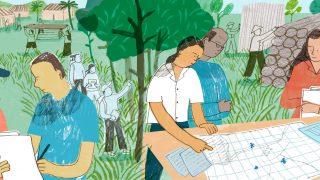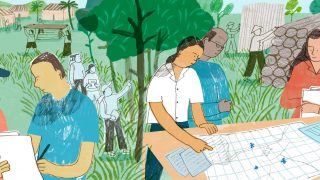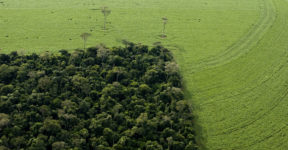
Forest Governance and Deforestation: Exploring the Disparity
Effective forest governance is critical to achieving sustainable forest management and reducing deforestation. Yet, while forest governance has been improving, forests continue to be lost at an alarming rate. Alison Hoare explores why there is such a disparity.
Over the last decade, forest governance has improved markedly in many countries as a result of concerted efforts to reduce illegality in the sector, according to research by Chatham House conducted in nine tropical forest countries.
Among the biggest changes seen have been improvements in transparency with the establishment of more open decision-making processes and better access to information as well as the clarification and reform of legal frameworks. Important progress has also been made in managing timber supply chains and in strengthening independent monitoring of the sector.
However, at the same time as forest governance is improving, the UN reports that deforestation and biodiversity loss is continuing at an alarming rate. Effective forest governance is often described as a prerequisite for sustainable forest management and for reducing forest loss and degradation. So why is the progress being made on forest governance not being translated into a reduction in deforestation?
One reason is that significant governance challenges are still to be found in the forest sector. In particular, in many countries, law enforcement remains weak and levels of corruption are high. There has also been a failure to adequately reform artisanal and small-scale logging and to regulate burgeoning domestic markets. As a result, the impact of the governance improvements that have been achieved so far has been limited.
Adding to these shortfalls within the sector, and in many cases overriding them, has been the demand for forest land from other sectors, in particular, from agriculture. This is clearly shown in analysis by the World Resources Institute (WRI) that reveals agriculture was the main driver of deforestation between 2010 and 2015 in all bar one of the nine countries. Shifting agriculture was the main driver in Cameroon, the Democratic Republic of Congo, Ghana, Papua New Guinea and the Republic of Congo while agriculture for export was the main driver in Brazil, Indonesia and Malaysia. The one exception is Lao People’s Democratic Republic (PDR) where forestry has been the main driver – although agriculture for export was a close second.

This clearly shows that concerted action is needed beyond the sector if deforestation is to be controlled. However, while there are limitations as to what can be achieved through forest governance reforms, it remains crucial.
There are two reasons for this. Firstly, much of the deforestation that is driven by other sectors is illegal, and so, improved enforcement in the forest sector has a critical role to play in addressing this. Secondly, establishing a thriving sector will help to make the case – economic, social and environmental – as to why countries need to conserve their forests.
On the second point, there is in fact evidence that many forests around the world are being managed better thereby giving some cause for optimism. A number of countries have been making progress in tackling illegal logging and the forest area that is being managed sustainably has also increased.
Analysis by Chatham House indicates that legal compliance improved in many of the countries studied since the turn of the century. It also revealed that the proportion of illegal exports of timber had declined although domestic markets still remained problematic – the total volume of illegal timber exports for the nine countries was estimated at just over one third in 2000 dropping to just over one quarter in 2014.
The area of forest certified as sustainable under the international schemes of the Forest Stewardship Council (FSC), or Programme for the Endorsement of Forest Certification (PEFC), has also grown markedly in these countries over the same period from 900,000 ha in 2000 to over 21 million ha in 2018.
Furthermore, in Indonesia, the area of forests under its national sustainable certification scheme has increased rapidly with over half of both natural and plantation forests certified as sustainable in 2016.
This progress is particularly important because sustainable forest management is one of the most effective land-use options for tackling climate change while also supporting sustainable development as was recently highlighted in the Intergovernmental Panel on Climate Change’s report on climate change and land. As countries review their climate commitments under the Paris Agreement, in addition to their strategies for achieving the Sustainable Development Goals, it is important to consider how the achievements seen to date in the forest sector can be reinforced and scaled up to help countries meet their 2030 ambitions. Three priority areas for action within forest countries are identified.

Illustration by Charlotte Ager
Law enforcement remains hugely under-resourced in most of the countries investigated: a limited number of field staff are responsible for monitoring and controlling vast areas of forest and often lack training and essential equipment.
Anti-corruption agencies are also faced with limited resources and may lack political support while the judiciary often have a limited understanding of forest sector crimes thereby resulting in these not being adequately dealt with.
The potential impact of prioritizing law enforcement is apparent from the examples of Brazil and Indonesia. Concerted efforts to halt illegal logging in Brazil played a large part in the country’s success in slowing deforestation between 2004 and 2009. The reverse is now being seen however. Support for forest law enforcement has declined over a number of years – worsening dramatically since the change of government in 2019 with drastic cuts to the budgets of enforcement agencies as well as a strong political message being conveyed that undermines their role. The outcome of this has been a decline in the rule of law in the Amazon as made evident from the increasing rates of forest loss since 2015 and widespread forest fires in 2019.
In contrast, in recent years, Indonesia has prioritized anti-corruption and broader law enforcement in the forest sector with an increase in resources, a high-level of political commitment to tackling corruption and greater recognition of civil society monitoring. This has been a factor in the reduction in deforestation seen since 2015 although there are two cautionary notes.
Firstly, as in Brazil, there have also been extensive forest fires in Indonesia in late 2019. It remains to be determined if these are less extensive as a result of the government’s efforts over the last few years to prevent forest fires but they clearly demonstrate that further action is needed.
Secondly, in September 2019 a law was passed reducing the powers of the country’s anti-corruption agency which casts doubt as to whether there remains a genuine commitment to tackling corruption.
Nevertheless, these examples highlight the importance of improving enforcement efforts. This requires increasing investment in all aspects of enforcement from investigation through to prosecution, and most importantly, it requires high-level political support.

Illustration by Charlotte Ager
Most of the progress made in the forest sector over the last decade has been in supply chains for export markets rather than domestic markets. These advances have been important but they are at risk of being undermined by the rapid growth of domestic markets and of the informal, small-scale sector which is the main source of timber for these markets. To address this, a multi-pronged approach is required.
On the one hand, there is the need to improve control of the domestic market. The various national wood-tracking systems being implemented should make an important contribution towards this and better law enforcement is also critical.
Public procurement policies are another valuable tool to help shift markets towards legal compliance. This approach has been used to increase the purchase of legal and sustainable timber in the state of São Paulo in Brazil while both Cameroon and Ghana have drafted timber procurement policies.
With a number of countries committed to expanding green public procurement, there is an opportunity for much greater use of this policy tool to help transform timber markets.
In parallel, more concerted efforts are needed to reform and regulate small and medium-sized enterprises so that they are able to comply with the law. Some progress has been made in clarifying laws and regulations, for example, in Cameroon, the Democratic Republic of Congo and Lao PDR.
Significant resources have also been invested in capacity support, in particular, in Indonesia and Ghana to support compliance with their national timber-tracking systems. However, these efforts need to be scaled up to reach the tens of thousands of such enterprises that continue to operate in the informal sector and which are such an important part of rural economies.
Complementary to these efforts, improvements are needed in the collection of data, for example, none of the countries reviewed collect comprehensive data on employment in the small-scale or informal forest sectors. Better statistical information will help to increase awareness of the economic importance of the small-scale sector and facilitate the planning of capacity-building efforts.

All of the countries studied have recognized the forest sector as critical to implementing their climate change strategies variously through tackling illegal logging, implementing sustainable forest management or reducing deforestation. However, the continued high rates of deforestation highlight the limited success they have had in achieving these objectives.
A key challenge has been policy incoherence and weak institutional coordination between the different land-use sectors. Some alignment and clarification of laws has been achieved including improved regulation of forest clearance, for example, in Lao PDR and the Republic of Congo.
Improvements to land-use management have also been made, for example, legal and institutional reforms in Ghana have improved the process for land rights registration, while in Indonesia, implementation of the One Map Policy is helping to clarify land and resource rights and usage.
However, much faster and more far-reaching change is needed in all countries to establish a coherent framework for land-use decision-making. To achieve this, the most important element that is needed is a strong political vision for sustainable development in which the integral role of forests is fully recognized and accounted for. Without this, agriculture, and other economic activities, will continue to drive deforestation.
Related Countries
- 1.Forest governance refers to the organizations, people, formal and informal rules, instruments and processes through which decisions are made relating to forests.


